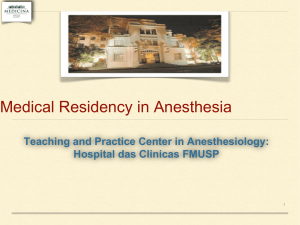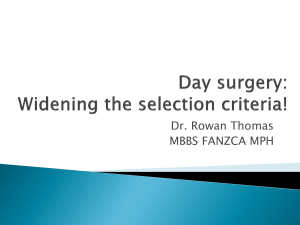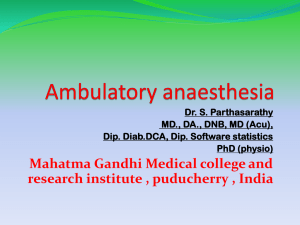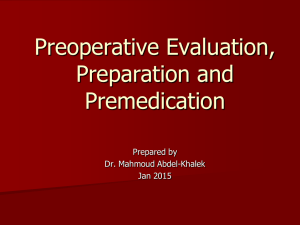Anesthesia for day case surgery
advertisement
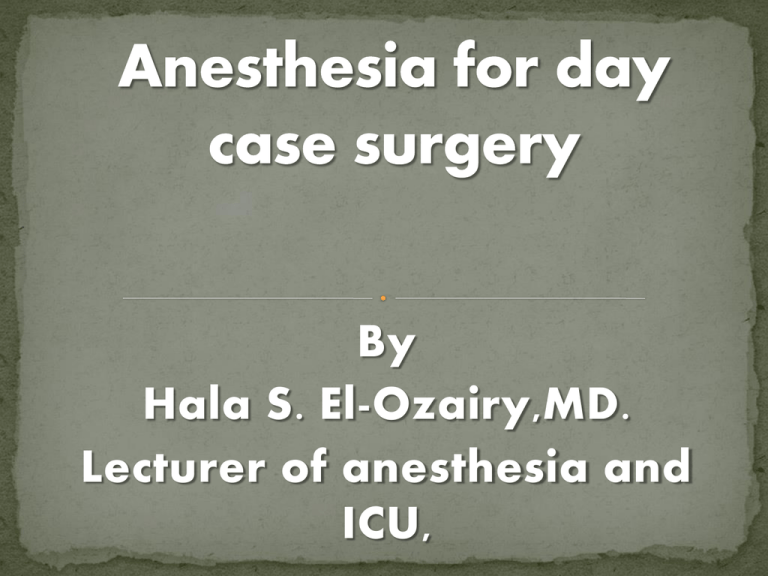
By Hala S. El-Ozairy,MD. Lecturer of anesthesia and ICU, Definition. Day case unit. Advantages. Disadvantages. Suitability for day case surgery. Contraindications. Patient preparation. Choice of anesthesia. Postoperative management. A surgical day case is defined by the Royal College of Surgeons of England as "a patient who is admitted for investigation or operation on a planned non-resident basis and who nonetheless requires facilities for recovery". Day case surgery must be distinguished from 'out-patient cases'. These are minor procedures performed under a local anesthetic which do not generally require postoperative recovery time. An outpatient is a patient who is not hospitalized overnight but who visits a hospital, clinic, or associated facility for diagnosis or treatment. Treatment provided in this fashion is called ambulatory care. Ambulatory anesthesia is tailored to meet the needs of ambulatory surgery so the patient can go home soon after the operation. Hospital integrated: The patients are managed in the same facility as inpatients but they may have separate preoperative preparation and second stage recovery area. Hospital based: Separate day case facility within a hospital handling only day cases. Free standing: These surgical and diagnostic facilities may be associated with hospitals but are housed in separate buildings that share no space or patient care functions. Reception area. Play room (pediatric). Discharge area. Anesthetic room. Operating room (fully equipped). Recovery room. Day case surgery is advantageous to several groups: patients: know when operation will be, little risk of cancellation. minimal time away from home which is particularly beneficial for pediatric patients. Earlier ambulation. It decreases the risk of nosocomial infection especially in children. surgeons: less risk of cancellation permits better scheduling of operating lists . greater turnover of cases. less delay between cases, usually because less preparation is required. release of in-patient beds that would have been occupied by day case patients. Day case surgery is advantageous to several groups: Hospital management: financial saving ranging from 19% to 70% compared to in-patient treatment. cost-effective treatment, still attaining clinical goals. facilitates less demand for in-patient beds. Disadvantages of day case surgery include: the need for a responsible person to oversee the day case patient at home for the first 24-48 hours. the restriction of day case surgery to experienced senior staff; little opportunity for junior staff to practice. extra work for the general practitioner in the postoperative period; patients often ring them for advice or treatment. It is done by: Preoperative visit. Telephone interview. Review of healthcare questionnaire which can be done using the internet. All are usually done by the anesthetist. Issues when assessing a patient's appropriateness for day surgery include: • physical status - ASA I or II are permitted. • Age. type of surgery. length of anesthesia. type of anesthesia. recovery criteria. Transport. postoperative pain relief. Although the acceptability of patients at the extremes of age (i.e., <6 months and >70 years) has been questioned, age alone should not be considered a deterrent in the selection of patients for ambulatory surgery. Many studies have failed to demonstrate an agerelated increase in recovery time or incidence of complications after ambulatory anesthesia. Even the so called elderly patient (>100 years) should not be denied ambulatory surgery solely on the basis of age. Operations for day case surgery vary between specialties. Appropriateness may be expanded by the facility for an overnight stay. Generally operations should be: Short duration (<90 min). Low incidence of postoperative complications. Not requiring blood transfusion. Not requiring major postoperative analgesia. Surgery should be performed by an experienced surgeon. Gynae: D&C, laparoscopy, VTOP, colposcopy. Plastics: removal of skin lesions, Dupuytren‘s contracture release, nerve compressions. Ophtalmics: Strabismus correction, lacrimal duct probing, EUA. ENT: Adenoidectomy, Tonsillectomy, myringotomy, Grommets, Removal of FB, polyp removal. Urology: Cystoscopy, circumcision, vasectomy. Orthopedics: arthroscopies, carpal tunnel release, ganglion removal. General Surgery: Breast lumps, varicose veins, herniae, endoscopy. Peds: Circumcision, orchiopexy, Squint, dental extractions. Medical Psychological Conditions Social Cardiovascular: Prev MI. Hypertension, diast.>100 mmHg. Angina, at rest, low exercise tolerance. Arrhythmias. Cardiac failure. Respiratory: Acute RTIs. Asthma requiring reg beta-2 agonists or steroids. COPD. Metabolic: Alcoholism. IDDM. Renal failure. Liver disease. Neurological, Musculoskeletal: Arthritis jaw, neck, cervical spondylosis, ankylosing spondylitis. Myopathies, muscular dystrophies or Myasthenia gravis. MS. CVA or TIA. Epilepsy > 3 fits/year. Drugs: Steroids. MAO inhibitors. Anticoagulants. Antiarrhythmics. Insulin. psychologically unstable, e.g. psychosis. concept of day surgery unacceptable to patient. lives over one hour away from unit. no reliable person to drive patient home after surgery and look after them for the first 24-48 hours postoperatively. at home, no access to a lift, telephone or indoor toilet and bathroom. Full explanation. Pt should be given written instructions incuding: Pre-op fasting: • Nil by mouth from midnight (solids). • Clear fluids until 3 hours pre-op. Pt‘s usual medication (i.e antihypertensives should be taken, oral hypoglycaemics should be omitted). Pts should bring in their own medications. Pt should stop smoking. The date and time of attendance. Complete registration is done. Informed consent is signed. List of the investigations required. Age range Men Women <40 None Pregnancy test 40–49 ECG Hematocrit level, pregnancy test 50–64 ECG Hemoglobin or hematocrit level, ECG 65–74 Hemoglobin or hematocrit level, ECG, serum urea nitrogen, glucose Hemoglobin or hematocrit level, ECG, serum urea nitrogen, glucose >75 Hemoglobin or hematocrit level, ECG, serum urea nitrogen, chest radiograph Hemoglobin or hematocrit level, ECG, serum urea nitrogen, chest radiograph • The patient meets the anesthesiologist who will review his medical and anesthesia history and the results of any laboratory tests and will answer any further questions. • Nurses give the patient the identifying bracelet and record the vital signs, and the anesthesiologist and surgeon then visit to complete any evaluations and mark the site of surgery. • Intravenous fluids will be started and preoperative medications given. Benzodiazepines: if indicated. Temazepam provides effective anxiolysis without delays in recovery and discharge times. Antiemetics: p.o preop or i.v. periop for high risk pts (i.e. 5 HT-antagonists, dexamethasone in ped). Antacids: if risk of acid reflux (H2-antagonists). Analgesics: Paracetamol and NSAIDs. There are several types of anesthetic techniques available for day case surgery ranging from local anesthesia to general anesthesia. The anesthetic technique recommended depends on several factors. In some cases, the surgical procedure dictates what kind of anesthesia will be needed. General anesthesia Regional anesthesia. Monitored anesthesia care (MAC). Choice of agents depends on requirements of pt and preference of anesthetist. Induction agent: • i.v. Propofol is used widely (easy &quick recovery, clear head, little PONV). • gas: Sevoflurane is non-irritant to airway, rapid induction, minimal side-effects, but more PONV. Maintainance: • N2O: higher incidence PONV, but lower requirements for volatiles. • TIVA: Propofol +/- Remifentanil…high cost. • VIMA: Sevoflurane (more PONV). Airway: GA mask, LMA, COPA or even ETT. Muscle-relaxants: • Succinylcholinemuscle pains. • NDMRshort-acting, Atracurium, Mivacurium, Vecuronium, Cisatracurium. Standard. Monitoring Awareness: • Stability of blood pressure and heart rate. • Lack of patient movement in response to surgical stimulation. • The bispectral index : BIS has been shown to be a reliable indicator to prevent awareness and facilitate rapid emergence from anesthesia. • avoidance of general anesthetic with its related complications. • minimal incidence of nausea and vomiting. • improved post-operative pain relief. • shortened recovery room time (can by-pass first-stage recovery). Advantages • ability to communicate with staff during surgery. to patient • ability to observe the procedure (arthroscopy). • earlier mobilization including immediate physiotherapy. Advantages to surgeon • enables accurate assessment of function before end of surgery. • allows discussion of operative findings and treatment options at surgery. • options of direct transfer to second-stage recovery. • shortens patient’s time in recovery room. • reduces post-operative nursing requirements. Advantages • fewer hospital admissions for institution • overall reduction in facility costs. Takes longer because of: • discussion with patient. • block procedure. • onset time. • gentle tissue handling. • incomplete block necessitating supplementation or conversion to general anesthetic. Requires surgeon and patient co-operation. Risk of post-spinal headache. Prolonged regional block may result in urinary retention and delayed discharge (central blocks). A number of regional anesthetic techniques can be used for day-case surgery: At completion of surgery, infiltration of the wound using a long-acting local anesthetic (e.g. 0.25% bupivacaine) provides prolonged postoperative analgesia. For ocular surgery, peribulbar, retrobulbar or topical blocks can be performed safely, effectively and with few complications. Caudal block is easy to perform and provides excellent analgesia for perineal or inguinal surgery. Blocks may be performed on the ilioinguinal nerve, iliohypogastric nerve, the brachial plexus, femoral nerve or digital nerves. Ring blocks of the wrist or ankle and local infiltration are simple and effective. IVRA is most suitable for short duration (<45–60 min) surgical procedures in distal extremities (forearm, hand, ankle and foot). Good surgical anesthesia can be achieved rapidly after the injection of local anesthetic and recovery is fast after the release of the tourniquet. The published success rates range from 94% to 100%. The main problems of the technique are related to the requirement for a tourniquet, and include restricted area of anesthesia, pain associated with the tourniquet, and risk of local anesthetic toxicity due to accidental release of the tourniquet. Peripheral nerve blocks provide excellent analgesia over a limited field and with minimal systemic effects. Peripheral nerve blocks have extended the indications for day-case surgical procedures such as major shoulder surgery and knee reconstruction. Avoid techniques that may be associated with occult complications, e.g: supraclavicular approach (pneumothrax). • It was previously called conscious sedation. • It is a combination of local anesthesia with intravenous sedation and analgesic drugs under monitor by the anesthetist. • Up to 50% of all day case procedures can be performed with a MAC technique. Postoperative complications. Discharge criteria. Anesthetic complications • PONV • Pain • Others: prolonged somnolence, headache, urinary retention, muscle pain, sore throat, hoarseness, croup, IV site problems. Medical complications • CVS: hyper or hypotension, arrhythmias, CHF,….. • Pulmonary: bronchospasm, atelectasis, aspiration,…. Surgical complications • Bleeding • Unsuccessful procedures Patient related factors Anesthesia related factors Surgery related factors • Age. • Gender. • Pre-existing disease (e.g.: Diabetes) • History of motion sickness. • History of PONV. • Smoking • Level of anxiety • Premedication. • Opioid analgesia. • Induction and maintenance drugs. • Reversal drugs. • Gastric distention. • Inadequate hydration. • Operative procedure: Strabismus, orchiopexy,.. • Length of surgery. • Blood in the GIT: tonsillectomy,… • Forcing oral intake. • Premature ambulation (postural hypotension). • Pain. Should start pre- or intraoperative by: Opioids:Short-acting opioids (Fentanyl, Alfentanil), avoid Morphine if possible if high risk of PONV. LA/regional blocks (i.e. Caudal block in kids; Ropivacaine more selective sensory block than Bupiv.). Ketorolac: 0.5-1 mg/kg Iv or IM. It does not cause nausea or vomiting or respiratory depression. Acetaminophen: 25-40 mg/Kg orally or rectally. Cox-2 inhibitors: Parecoxib 20-100 mg Iv or IM. No GIT side effects of other NSAIDs. Prior to discharge from the day case unit patients should: • • • • • • Have stable vital signs. Be alert and orientated. Be comfortable / pain free. Be able to walk. Be able to tolerate oral fluids. Have minimal nausea and vomiting. Adequate follow-up arrangements should be made. Patients should be provided with information sheets. Should be provided with contact telephone numbers. Thanks

